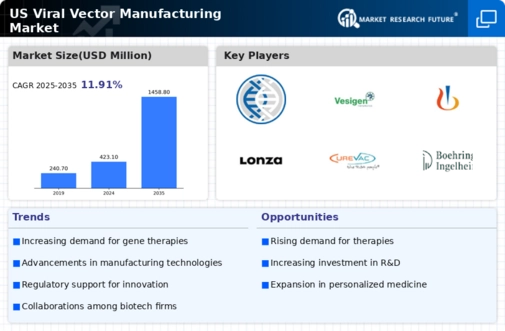The viral vector-manufacturing market is characterized by a dynamic competitive landscape, driven by advancements in gene therapy and vaccine development. Key players such as Sangamo Therapeutics (US), Novartis (CH), and Pfizer (US) are at the forefront, each adopting distinct strategies to enhance their market positioning. Sangamo Therapeutics (US) focuses on innovative gene-editing technologies, while Novartis (CH) emphasizes strategic partnerships to bolster its research capabilities. Pfizer (US), on the other hand, is heavily investing in digital transformation to streamline its manufacturing processes, thereby enhancing operational efficiency. Collectively, these strategies contribute to a competitive environment that is increasingly focused on innovation and collaboration.
In terms of business tactics, companies are localizing manufacturing to reduce lead times and optimize supply chains. The market appears moderately fragmented, with several players vying for dominance. However, the influence of major companies is substantial, as they leverage their resources to shape market trends and drive technological advancements. This competitive structure fosters an environment where innovation is paramount, and companies are compelled to differentiate themselves through unique offerings and operational efficiencies.
In October 2025, Sangamo Therapeutics (US) announced a collaboration with a leading biotech firm to develop next-generation gene therapies. This partnership is expected to enhance Sangamo's capabilities in viral vector production, allowing for more efficient and targeted therapies. The strategic importance of this collaboration lies in its potential to accelerate the development timeline of new treatments, thereby positioning Sangamo as a leader in the rapidly evolving market.
In September 2025, Novartis (CH) expanded its manufacturing footprint by acquiring a facility in the US dedicated to viral vector production. This acquisition is significant as it not only increases Novartis's production capacity but also enhances its ability to meet the growing demand for gene therapies. The move reflects a broader trend of consolidation within the industry, where companies seek to bolster their operational capabilities through strategic acquisitions.
In August 2025, Pfizer (US) launched a new initiative aimed at integrating artificial intelligence (AI) into its manufacturing processes. This initiative is poised to revolutionize the way viral vectors are produced, potentially leading to increased efficiency and reduced costs. The strategic importance of this development cannot be overstated, as it positions Pfizer at the cutting edge of technological innovation in the market.
As of November 2025, current trends in the viral vector-manufacturing market include a strong emphasis on digitalization, sustainability, and AI integration. Strategic alliances are increasingly shaping the competitive landscape, enabling companies to pool resources and expertise. Looking ahead, it is likely that competitive differentiation will evolve, with a shift from price-based competition to a focus on innovation, technology, and supply chain reliability. This transition underscores the importance of agility and adaptability in a market that is rapidly changing.
























Leave a Comment